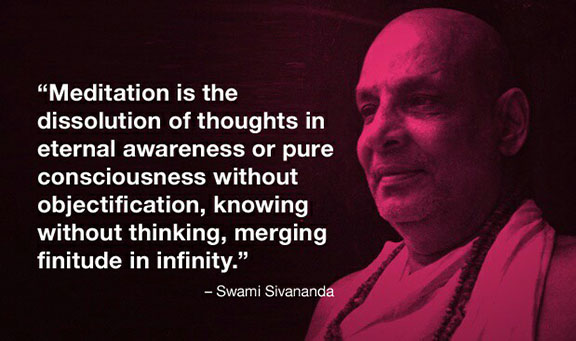 Patanjali’s Yoga system is written in sutras. A sutra is a terse verse. It is an aphoristic saying. It is pregnant with deep, hidden significance. Rishis of yore have expressed philosophical ideas and their realization in the form of sutras only. It is very difficult to understand the meaning of the sutras without the help of a commentary, a gloss or a teacher who is well-versed in Yoga.
Patanjali’s Yoga system is written in sutras. A sutra is a terse verse. It is an aphoristic saying. It is pregnant with deep, hidden significance. Rishis of yore have expressed philosophical ideas and their realization in the form of sutras only. It is very difficult to understand the meaning of the sutras without the help of a commentary, a gloss or a teacher who is well-versed in Yoga.
Raja Yoga is mainly concerned with the mind, its modifications and its control. There are five states of the mind—kshipta, mudha, vikshipta, ekagra and niruddha. Usually the mind is running in various directions; its rays are scattered. This is the kshipta state. Sometimes it is self-forgetful, it is full of foolishness (mudha). When you try to practice concentration, the mind seems to get concentrated but gets distracted often. This is vikshipta. But with prolonged and repeated practice of concentration again and again, and repeating Lord’s Name, it becomes one-pointed. This is called the ekagra state. Later on, it is fully controlled (niruddha). It is ready to be dissolved in the Supreme Purusha, when you get Asamprajnata samadhi.
To have peace of mind, you will have to cultivate the four great virtues—maitri, karuna, mudita and upeksha. maitri (friendliness), you should have towards equals. You should have karuna (compassion) for those who are in distress. You should have mudita (complacency) towards those who are superior to you. Complacency will destroy jealousy. All are your brothers. If a man is placed in a better position, feel happy over it. When you come across wicked people, be indifferent to them. This is upeksha (indifference). By these methods, you will have peace of mind.
The five kinds of afflictions are: Avidya (ignorance), asmita (egoism), raga (attraction), dvesha (aversion) and abhinivesha (clinging to mundane life). Samadhi destroys all this. Raga and dvesha have five states—udara (fully manifest), vicchinna (hidden), tanu (thinned out), prasupta (dormant) and dagdha (burnt). In worldly-minded people who are sunk in worldliness, raga and dvesha assume an udara avastha; they are in an expanded state i.e., they have a full and unhampered play.
Vicchinna avastha is that state in which raga and dvesha are hidden. The husband and wife sometimes quarrel; then love is temporarily hidden. Again she smiles; then love comes back. This is vicchinna avastha. Some people do a little bit of pranayama, kirtan and japa. In them raga and dvesha become thinned out (tanu avastha). Sometimes, on account of unsuitable conditions, they lie dormant (prasupta avastha). In samadhi they are burnt—dagdha. Raga and dvesha constitute this samsara. They constitute the mind.
Mind is a force which has no real entity but appears to be for the time being, and deludes the jivas. It is superior to prana. It is superior to matter. But, above the mind there is discrimination. Discrimination can control the mind; enquiry into your real nature or Atma-vichara can control the mind. If you destroy the raga-dvesha through meditation and samadhi, the mind will be annihilated. Your effort should be daily to practice concentration, even for five or ten minutes; then you will be able to control the mind and enter into samadhi.
Try to get established in yama and niyama, and at the same time practice asana, pranayama and meditation as much as you can. The two must go hand in hand. Then success will be rapid. You will soon enter into nirvikalpa samadhi and attain kaivalya moksha [liberation]. What that supreme state is no one has described, and no words can describe. Practice, O bold aspirant, and realize it for yourself. May you shine as a Yogi in this very birth!
Source: Raja Yoga by Sri Swami Sivananda

